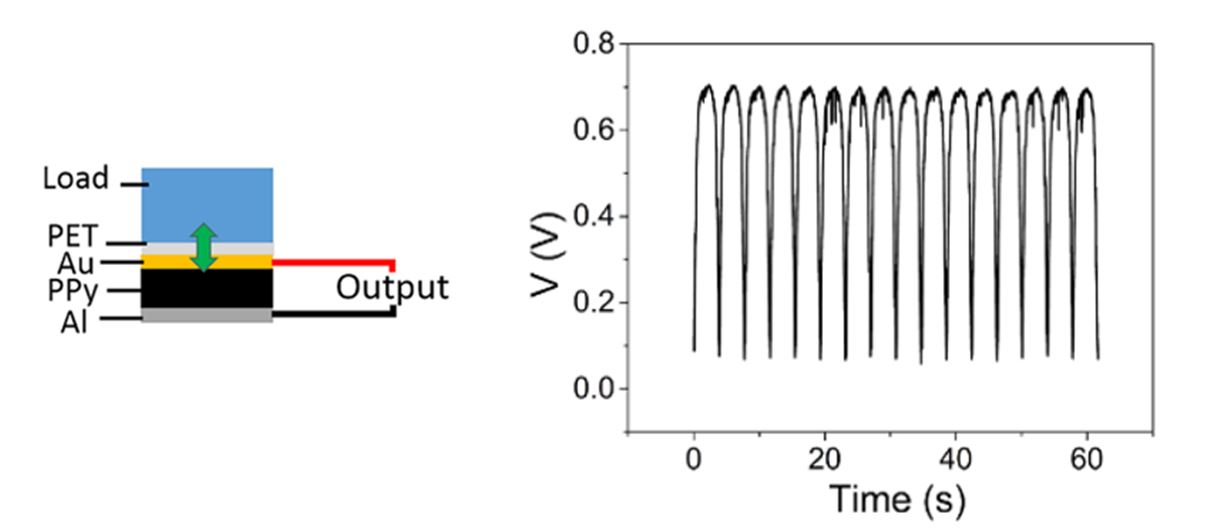Video Article Open Access
Conducting Polymer-based DC Generators
Tong Lin1,*, Hao Shao1, Jian Fang2, Hongxia Wang1, Wenyu Wang3
1Institute of Frontier Materials, Deakin University, Geelong, Vic, 3216 Australia
2College of Textile and Clothing Engineering, Soochow University, Suzhou, 215123, China
3School of Textile, Tianjin Polytechnic University, Tianjin, 300387, China
Vid. Proc. Adv. Mater., Volume 2, Article ID 2021-02131 (2021)
DOI: 10.5185/vpoam.2021.02131
Publication Date (Web): 27 Mar 2021
Copyright © IAAM
Graphical Abstract

Abstract
In recent years, harvesting small mechanical forces into electrical energy from daily activity, human motion, and vibration, has received much attention owing to the potential applications in powering personal electronics, development of self-powered electronic systems, health/aged care, and human-machine interfacing. Many new energy conversion materials and technology have been reported for these purposes. However, most of the energy harvesters produce alternating current (AC), which must be rectified into DC before use because most microelectronics are designed to be powered by direct current (DC). Generators that can generate DC without rectification will bring many benefits but remain a challenge to develop.
In 2016, we first reported an interesting energy conversion phenomenon on Schottky diodes. A Schottky diode made of conducting polymers and low work function metals can directly convert mechanical energy into direct current without rectification [1]. For the Schottky diode from polypyrrole and aluminum metal, under compression, it can generate a peak voltage output of 0.7 V and a current density of 62.4 μA cm-2. The power generation originates from the compression caused barrier height reduction and conductivity increase, the mechanism of which is completely different from the conventional piezoelectric materials and devices. We further uncovered that dopants in conducting polymers played a critical role in deciding the current output. When protonic acids were used as the dopant, the one with a smaller molecular size led to larger electrical outputs [2]. When a small amount of graphene oxide was incorporated into the conducting polymer, the device shows significantly improved current output with minimal change in the output voltage [3]. We also prepared a flexible DC generated using polypyrrole coated fabric. The Schottky diode made of PPy-coated fabric and aluminum can produce a peak voltage output as high as 3.27 V and a current output up to 0.82 A m-2 [4]. The voltage is 4.6 times higher when compared with Al/PPy/Au Schottky generator that was prepared from a dense PPy plate. We also found that a p-n junction made of conducting polymer and inorganic semiconductor under compression can generate DC power [5]. This lecture will introduce our major findings in this area.
Keywords
Energy harvesters; schottky diodes; DC output; conducting polymers.
Acknowledgement
Funding support from the Australian Research Council through a discovery project (DP180101161) and Nantong Science and Technology Project (JC2018040) is acknowledged.
References
- H. Shao, J. Fang, H. Wang, L. Dai, T. Lin, Adv. Mater., 2016, 28, 1461.
- H. Shao, J. Fang, H. Wang, H. Zhou, H. Niu, F. Chen, G. Yan, S. Fu, Y. Cao, T. Lin, Advanced Electronic Materials, 2019, 5, 1800675.
- H. Shao, J. Fang, H. Wang, H. Niu, H. Zhou, Y. Cao, F. Chen, S. Fu, T. Lin, Nano Energy, 2019, 62, 171.
- W. Wang, X. Han, J. Niu, X. Jin, H. Wang, H. Shao, T. Lin, Journal of Materials Chemistry A, 2020, DOI:org/10.1039/D0TA09342D.
- H. Shao, J. Fang, H. Wang, T. Lin, Journal of Materials Chemistry A, 2017, 8267-8273.
Biography
Tong Lin obtained a Ph.D. in physical chemistry from the Chinese Academy of Sciences in 1998. Since 2013, he has been a Professor and Personal Chair of Deakin University. Before that, he served as a Research Academic, Senior Research Fellow, and Associate Professor at the Deakin University. Prof Lin has been an active researcher in the field of electrospinning, functional fibers, and polymers. He contributes to the development of needleless electrospinning technology for large-scale production of nanofibers and novel applications of nanofiber materials in various fields. Prof Lin has authored or co-authored over 270 peer-reviewed journal articles, 37 books/book chapters, and 90 other papers. Based on the Google Scholar database, the total citation of his publications is over 12,400, with an h-index over 61. Prof Lin has also been awarded the Australian Research Council (ARC) Future Fellow and Fellow of the Royal Society of Chemistry (RSC, UK).
Video Proceedings of Advanced Materials

Upcoming Congress



